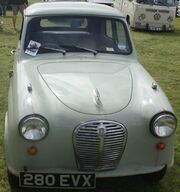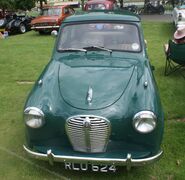
Austin A30
The A30 was a compact car produced by Austin Motor Company in the 1950s. Introduced in 1951 as the "New Austin Seven", it was Austin's answer to the Morris Minor. At launch the car cost £507, undercutting the Minor by £62.
Features[]
The bodywork, designed by an aeronautical engineer, was fully stressed monocoque construction, the first Austin to be made in this way, which made it both lighter and stiffer than most contemporary vehicles. Inside there were individual seats at the front and a bench at the rear covered in PVC but evidence of economy was seen in only having a single windscreen wiper and sun visor in front of the driver. A passenger side wiper and sun visor, and a heater were available as extras.
Despite originally only being offered as a 4-door saloon, 2-door variants were introduced in 1953, and in 1954 a van and van-based "countryman" estate were made available. Despite having a smaller loading capacity than the equivalent BMC O-type Minor based vans (60 cu ft / 1.70 m3 as opposed to 76 cu ft / 2.15 m3) the Austin van offered the same payload. Being slightly lighter and stiffer, it was favoured by businessmen, and saw long service for many.
The saloon car was replaced by the A35 in 1956 after having sold nearly ¼ million units but the Countryman estate lasted until 1962 and vans until 1968.
The A30 had a smaller rear window than the A35 andtrafficators instead of modern indicators which popped out from the B pillar when operated by a knob mounted on the centre of the dashboard. The car was quite successful in 1950s saloon car racing and some still appear in historic events.
Performance[]
Its newly designed A-Series straight-4 engine was state of the art for the time and returned an average fuel consumption of 42 mpg / under 7L/100 km. With spirited driving the A30 was able to attain a top speed of 70 mph (110 km/h) (factory quoted). In their road test The Motor magazine achieved a top speed of 67.2 mph (108.1 km/h) and a 0–60 mph time of 42.3 seconds. Braking was effected by a hybrid system, with Lockheed fully hydraulic drum brakes at the front and a body mounted single cylinder operating rods to the wheels at the rear, which despite being heavily criticised as being archaic and old-fashioned, were reported as being quite acceptable. The rod system provided good handbrake efficiency and was applied by a lever in an unorthodox position to the right of the drivers seat (Right hand drive vehicles). Bumps were handled by independent coil springs at the front end and beam axle/semi-elliptic leaf springs at the back.
A car tested by The Motor magazine in 1952 had a top speed of 62 mph (100 km/h) and could accelerate from 0–50 mph (80 km/h) in 29 seconds. A fuel consumption of 38.8 miles per imperial gallon (7.28 L/100 km; 32.3 mpg-US) was recorded. The test car cost £553 including taxes. The optional radio was an extra £43 and the heater £9. Performance data need to be seen in the context of fuel availability. Early in the Second World War "branded fuel" disappeared from sale in the UK, and the nationally available fuel available at the beginning of 1952 had an octane rating of just 70, which enforced relatively low compression ratios: this reduced the performance available from all cars, especially small ones. In 1952 branded fuels returned to the forecourts, available octane ratings began to increase, and compression ratios were progressively improved along with the performance figures of cars such as the Austin A30 and its A35 successor.
Engine[]
- 803 cc BMC A-Series engine Straight-4.
- 58 mm bore x 76 mm stroke
- pushrod operated overhead valves
- compression ratio 7.2:1
- single Zenith carburettor
- 28 hp (21 kW) at 4400 rpm
- 40 lbf·ft (54 Nm) at 2200 rpm





